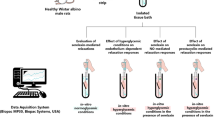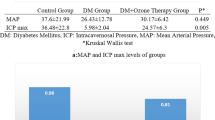Abstract
Prostaglandin D2 (PGD2) binds to specific G-protein coupled receptors (DP) and induces smooth muscle relaxation by stimulating the synthesis of intracellular cAMP. In this study, we examined the role of PGD2 and DP receptors in regulating human penile smooth muscle contractility. We determined that human corpus cavernosum tissue and smooth muscle cells in culture expressed functional DP receptor and lipocalin-like prostaglandin D synthase by reverse-transcribed polymerase chain reaction (RT-PCR). Functional PGD synthase activity was confirmed by the synthesis of PGD2 in human corpus cavernosum smooth muscle cells upon addition of exogenous arachidonic acid. Organ bath preparations of human corpus cavernosum tissue strips, contracted with phenylephrine, relaxed in a dose-dependent fashion to either PGD2 or the DP selective agonist BW245C. Cultures of human corpus cavernosum smooth muscle cells treated with BW245C showed a two-fold increase in cAMP synthesis. These data are consistent with the expression of functional DP receptors in human corpus cavernosum. This suggests the presence of an intact prostanoid autocrine system that may play a role in regulating penile erectile function.
This is a preview of subscription content, access via your institution
Access options
Subscribe to this journal
Receive 8 print issues and online access
$259.00 per year
only $32.38 per issue
Buy this article
- Purchase on Springer Link
- Instant access to full article PDF
Prices may be subject to local taxes which are calculated during checkout





Similar content being viewed by others
References
Pierce KL, Gil DW, Woodward DF, Regan JW . Cloning of human prostanoid receptors Trends Pharm Sci 1995; 16: 1–22.
Narumiya S, Sugimoto Y, Ushikubi F . Prostanoid receptors: structures, properties, and functions Physiol Rev 1999; 79: 1193–1226.
Andersson KE . Pharmacology of penile erection Pharmacol Rev 2001; 53: 417–450.
Nehra A, Barrett DM, Moreland RB . Pharmacotherapeutic advances in the treatment of erectile dysfunction Mayo Clin Proc 1999; 74: 709–715.
Boie Y et al. Molecular cloning and characterization of the human prostanoid DP receptor J Biol Chem 1995; 270: 18910–18916.
Kanaoka Y et al. Cloning and crystal structure of hematopoietic prostaglandin D synthase Cell 1997; 90: 1085–1095.
Urade Y, Hayaishi O . Prostaglandin D2 and sleep regulation Biochim Biophys Acta 1999; 1436: 606–615.
Okuda-Ashitaka E et al. Cyclic-AMP-dependent Ca2+ influx elicited by prostaglandin D2 in freshly isolated nonchromaffin cells from bovine adrenal medulla Biochim Biophys Acta 1993; 1176: 148–154.
Nagata A et al. Human brain prostaglandin D synthase has been evolutionarily differentiated from lipophilic-ligand carrier proteins Proc Natl Acad Sci USA 1991; 88: 4020–4024.
Roy AC, Tan SM, Kottegoda SR, Ratnam SS . Ability of human corpus cavenosum to generate prostaglandins and thromboxanes in vitro IRCS Med Sci 1984; 12: 608.
Daley JT et al. Prostanoid production in rabbit corpus cavernosum I. Regulation by oxygen tension J Urol 1996; 155: 1482–1487.
Moreland RB et al. Oxygen-dependent prostanoid synthesis activates functional PGE receptors on human corpus caver-nosum smooth muscle cells Am J Physiol 2001; 281: H552–H557.
Hedlund H, Andersson KE . Contraction and relaxation induced by some prostanoids in isolated human penile erectile tissue and cavernous artery J Urol 1985; 134: 1245–1250.
Palmer LS et al. Characterization of cyclic AMP accumulation in cultured human corpus cavernosum smooth muscle cells J Urol 1994; 152: 1308–1314.
Moreland RB et al. Misoprostol induces relaxation of human corpus cavernosum smooth muscle: Comparison to prostaglandin E1 Int J Impotence Res 2000; 12: 107–110.
Traish AM et al. G-protein-coupled receptor agonists augment adenylyl cyclase activity induced by forskolin in human corpus cavernosum smooth muscle cells Receptors and Signal Transduction 1997; 7: 123–134.
Moreland RB et al. PGE1 suppresses the induction of collagen synthesis by transforming growth factor-β1 in human corpus cavernosum smooth muscle J Urol 1995; 153: 826–834.
Edelstein RA et al. A rapid and simple method for the detection of prostate specific antigen mRNA in archival tissue specimens using a reverse transcription-polymerase chain reaction assay Urology 1995; 45: 597–603.
Watkins MT et al. Immediate responses of endothelial cells to hypoxia and reoxygenation: an in vitro model of cellular dysfunction Am J Physiol 1995; 268: H749–H756.
Kim N et al. Oxygen tension regulates the nitric oxide pathway. Physiological role in penile erection J Clin Invest 1993; 91: 437–442.
Gerashchenko D et al. Dominant expression of rat prostanoid DP receptor mRNA in leptomeninges inner segments of photoreceptor cells, iris epithelium, and ciliary processes J Neurochem 1998; 71: 937–945.
Tokugawa Y et al. Lipocalin-type prostaglandin D synthase in human male reproductive organs and seminal plasma Biol Reprod 1998; 58: 600–607.
Beasley RC et al. Effect of a thromboxane receptor antagonist on PGD2- and allergen-induced bronchoconstriction J Appl Physiol 1989; 66: 1685–1693.
Crider JY, Griffen BW, Sharif NA . Prostaglandin DP receptors positively coupled to adenylyl cyclase in embryonic bovine tracheal (EBTr) cells: pharmacological characterization using agonists and antagonists Br J Pharmacol 1999; 127: 204–210.
Kiriyama M et al. Ligand binding specificities of the eight types and subtypes of the mouse prostanoid receptors expressed in Chinese hamster ovary cells Br J Pharmacol 1997; 122: 217–224.
Giles H et al. The classification of prostaglandin DP-receptors in platelets and vasculature using BW A868C, a novel, selective and potent competitive antagonist Br J Pharmacol 1989; 96: 291–300.
Matsugi T et al. Selective prostaglandin D2 receptor stimulation elicits ocular hypotensive effects in rabbits and cats Eur J Pharmacol 1995; 275: 245–250.
Imoto Y et al. Alpha-subunit of Gs directly activates cardiac calcium channels in lipid bilayers Am J Physiol 1988; 255: H722–H728.
Yu HJ, Ma H, Green RD . Calcium entry via L-type calcium channels acts as a negative regulator of adenylyl cyclase activity and cyclic AMP levels in cardiac myocytes Mol Pharmacol 1993; 4: 689–693.
Lader AS et al. Cardiac Gs alpha overexpression enhances L-type calcium channels through an adenylyl cyclase independent pathway Proc Natl Acad Sci USA 1998; 95: 9669–9674.
Hayaishi O . Molecular mechanisms of sleep-wake regulation: roles of prostaglandins D2 and E2 FASEB J 1991; 5: 2575–2581.
Mizoguchi A et al. Dominant localization of prostaglandin D receptors on arachnoid trabecular cells in mouse basal forebrain and their involvement in the regulation of non-rapid eye movement sleep Proc Natl Acad Sci USA 2001; 98: 11674–11679.
Moreland RB . Is there a role of hypoxema in penile fibrosis? Int J Impot Res 1998; 10: 113–120.
Acknowledgements
The authors acknowledge the excellent technical assistance of Cynthia Gallant, Sandra Kwak and Erika Liné as well as the administrative assistance of Jerie McGrath-Cerqua. This work was supported by grants R29-DK47950, R01-DK39080, R01-DK40025 and K01-DK02696 from the National Institutes of Health and a grant from the General Research Service of the Veterans Administration (MTW).
Author information
Authors and Affiliations
Corresponding author
Rights and permissions
About this article
Cite this article
Moreland, R., Nehra, A., Kim, N. et al. Expression of functional prostaglandin D (DP) receptors in human corpus cavernosum smooth muscle. Int J Impot Res 14, 446–452 (2002). https://doi.org/10.1038/sj.ijir.3900900
Received:
Revised:
Accepted:
Published:
Issue Date:
DOI: https://doi.org/10.1038/sj.ijir.3900900
Keywords
This article is cited by
-
In vitro models: research in physiology and pharmacology of the lower urinary tract
British Journal of Pharmacology (2006)



